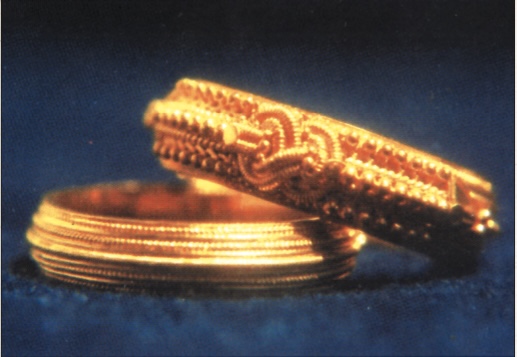By C.V. Manoj
From time immemorial it has been a tradition in India to make the pavithra ring out of the holy darbha grass and wear it during auspicious occasions and the performance of religious rites. There are references to the ring in the Mahabharatha and the Agni Purana.
According to our tradition in Kerala, the pavithra ring was made in gold for the first time during the Naveekarana-kalasam (Deity reinstallation ceremony) in the famed Sri Subrahmanya Swami Temple of Payyanur after the reconstruction of the ancient temple two centuries ago. It was the Thanthri (the chief authority on matters related to temples) of the temple, inspired by the Divine, who entrusted Sri Kelappan Perunthattan of the Chovvattavalappil family to make the ring in gold and gave him the necessary guidance. The adept craftsman accordingly grasped the structural nuances of the ring which made it potent with spiritual power. It was by wearing this pavithra ring in gold made by Sri Kelappan Perunthattan that the Thanthri completed all the rituals. Thereafter, it became a convention to make the ring in gold, and the successors of Sri Kelappan Perunthattan became traditional experts in its making.
For the fabrication of the ring in gold, the craftsman first converts gold into thin wires and then winds and twines them to form the patterns on a circular base. The special and precise manner of weaving the complex knot (as can be seen in the picture above) is its most important feature. It takes three days’ work to make a pavithra ring. The makers are always pure vegetarians and teetotalers. During the creation of the ring, they observe certain spiritual disciplines. After the completion of the work, the craftsman takes the ring to Sri Subrahmanya Swami temple of Payyanur for worship. With the performance of the worship, its spiritual potency is activated and it becomes vibrant with divine energy.
The structure of the ring is based on the yogic knowledge of the subtle energies in the human body. According to certain Shakta and yoga traditions, the kundalini, or spiritual force, lays dormant in the first chakra, the muladhara, at the base of the spine. For the kundalini to be released and move upward through the chakras, a psychic “knot” or seal called the brahma grandhi must be untied through the practice of spiritual disciplines. It is this brahma grandhi which is represented in the ring, and corresponds to the risen spiritual force of the priest necessary for him to correctly perform the rituals and invoke the Gods. Wearing of the pavithra ring implies an effort to achieve the inner purity for activating the kundalini energy to pierce the brahma grandhi, which brings a new dimension of harmony to human life.
Other explanations are given for the intricate design. One is that the interwoven gold strands represent the interwoven planes of existence or the infinite complex intertwinings of existence; another that they serve to ward off malevolent influences.
In Tamil Nadu, the Sivachariyar priests prefer to make the pavithra ring in its original form, from woven darbha grass. Only occasionally is it made from silver or gold in their tradition. The ring is worn only by the chief priest of the ceremony, one who is qualified to do a Mahakumbhabhishekam [temple rededication, the most complex of all ceremonies]. The chief priest must be married, and his wife must be living. Neither an unmarried priest nor a widower will wear the ring.
The pavithra ring is to be worn on the ring finger of the right hand. In most of the Vedic and Tantric rituals the right hand, with which the yajnas, homas and pujas are performed, is purified by wearing a pavithra ring on the ring finger.
In the Kerala tradition, we believe that holy devices like the pavithra ring, gems, rudraksha, etc., are catalysts that help us intensify our efforts to bring ourselves into communion with our spiritual dimension, into atunement with divine harmony.
Today in Kerala this ring is made to order for anyone willing to pay the price. A website (www.payyanur.com/pavithram.htm) for the Payyanur town, home to the Sri Subrahmanya Swami Temple associated with the ring, states, “According to tradition, the pavithra, before handed over to the customer, is taken to Payyanur Perumal Temple for special pujas [worship], and a part of the cost of the ring will be given to the temple as an offering. Payyanur pavithra rings are exhibited in many of the museums of India as well as abroad.” Among the priests, however, the ring is held in very high regard, a symbol of the spiritual attainment they must achieve inside themselves to correctly invoke God and the Gods in ceremony.
contact: C. V. Manoj, Integral Books,”Ayodhya,” Payyanur, Kerala 670 307 India
email:booksintegral@yahoo.com


